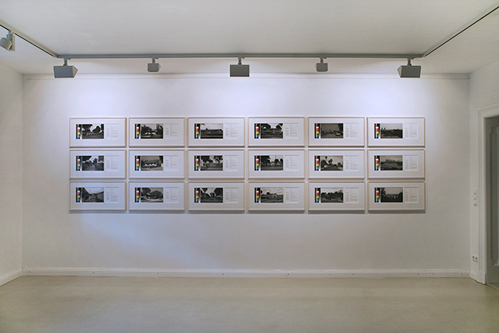[2011] Index of Livability
Photo-text series
40 x 76 cm (each)
Index of Livability unfolded from research on the history of social housing in Los Angeles. The starting point was the lesser-known interest and involvement of the renowned architect Richard Neutra in socio-political design. The project focuses on the six housing sites of Hacienda Village, Pueblo del Rio, Maravilla Village, Channel Heights, Elysian Park Heights and Progressive Builders Homes in the Los Angeles area, each of which were partly or fully designed by Richard Neutra.
Built in the early 1940's, these developments represented the utopian vision of modernist large-scale urban planning. Based on the idea of the communal, they were planned with social areas, open green space, children's playgrounds and no automobile traffic; specific locations even contained supermarkets, nurseries and primary schools, and some even formed the basis for co-operative movements and living experiments. Many residents of these projects were oriented to the political left, and were sympathetic to the perspectives of the left-liberal popular front, a fact that posed a threat to the government. In the early 1950's, the McCarthy era and cold war politics, plus a new emerging form of "corporate modernism" (Don Parson) shaped by economic growth and progress, along with the persistent believe that public housing was un-American, all together led to poor maintenance and the neglect of most of the developments' buildings. Followed by severe decay and gang activity, these former modernist experiments now represented contemporary sites of "urban hell", and were either partially or fully demolished, in turn making room for new suburban-type neighborhoods.
The photographs depicting the current sites of the developments in three parts (or perspectives) are each combined with a text box containing information about the locations' different stages during the past decades, as well as a list of references that may serve as a basis for further research. Within this context Index of Livability does not intend to document the sites as they are today, the project aims instead to describe a space that is created by the overlap of the actual site, the archive (with its indexed data), and the imaginary space of the once-utopian vision.
"[...] Squeezed between the archival data and the color chart, the actual scene brings a touch of mistrust in what we see. Perhaps it is because of knowing her photographs from one of the previous series, Substitute Locations, which she treated as an 'objective' documentation of something non-existent; a mere stage set offering an appearance of life, place and space. Both cases are potential (spatial) aporias, whose status may at first seem autonomous, yet actually depends on other people's interests. Nimmerfall's photographs document parallel spaces that, like heterotopias, function simultaneously, both questioning and confirming each other. [...]" - Sandra Križic Roban
< Index


